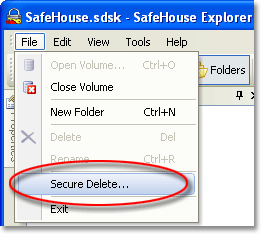![]() Secure Delete is a feature included with SafeHouse Explorer
which makes it easy for you to completely and truly delete files. When
you delete files the "normal" way in Windows, the data from
those files still exists somewhere on your hard drive. This can be very
helpful when you've deleted something by mistake and need to recover it
from your recycle bin; however, it also makes it easy for intruders to
view the contents of these files which you may have thought were long-since
deleted.
Secure Delete is a feature included with SafeHouse Explorer
which makes it easy for you to completely and truly delete files. When
you delete files the "normal" way in Windows, the data from
those files still exists somewhere on your hard drive. This can be very
helpful when you've deleted something by mistake and need to recover it
from your recycle bin; however, it also makes it easy for intruders to
view the contents of these files which you may have thought were long-since
deleted.
The Secure Delete feature works by overwriting files about to be deleted with random data patterns. This process completely destroys any wipes clean anything these files may have previously contained. Nobody, including law enforcement or the most-determined hackers, will be able to recover the contents of these files. Of course, this also means that if you securely delete files by mistake, that they will be forever gone and unrecoverable by even the most-sophisticated file recovery tools available.
The Secure Delete feature only works from within SafeHouse Explorer. Files you delete normally using Windows Explorer are not wiped clean as they would be when using SafeHouse Explorer.
Start SafeHouse Explorer.
Choose Secure Delete from the File menu.
Select any number of files and folders in the standard Windows file chooser dialog.
Confirm your intent to permanently delete the selected items.

You will see a series of progress meters displayed on screen as SafeHouse Explorer makes several passes through the selected set of files. During each pass, SafeHouse Explorer will overwrite the file with a different pattern. Files are then deleted.
You can adjust the amount of times your files are overwritten with random data using a preference setting on the Options dialog.
No, once a file is securely deleted, the data it contained is gone forever.
At this point, even if an intruder did gain access to your PC and attempted to use a commercial file recovery product to restore your deleted files, all they would see is the last random pattern written over the files. And by writing over files with multiple patterns, this technique thwarts even the sophisticated file recovery and analysis machines used by special agencies.
When you drag and drop files into SafeHouse Explorer from Windows Explorer while holding down the right mouse button, you'll be offered the option to perform a Secure Move. This option provides additional protection by performing a secure delete on the old files before they are finally deleted in Windows once the move is complete.
SafeHouse Explorer does not perform any actions on your Windows page file (pagefile.sys) or hibernation file (hiberfil.sys). These are system files used by Windows to work with memory swapping and hibernation. If you're not familiar with these special files, what's important to know is that these files can contain the contents of your PC's memory at various points in time, and it's possible that Windows might have flushed memory fragments from recently-viewed sensitive documents out to one of these files in order to free up memory.
SafeHouse Explorer does not touch these files since doing so could interrupt the normal operation of Windows.